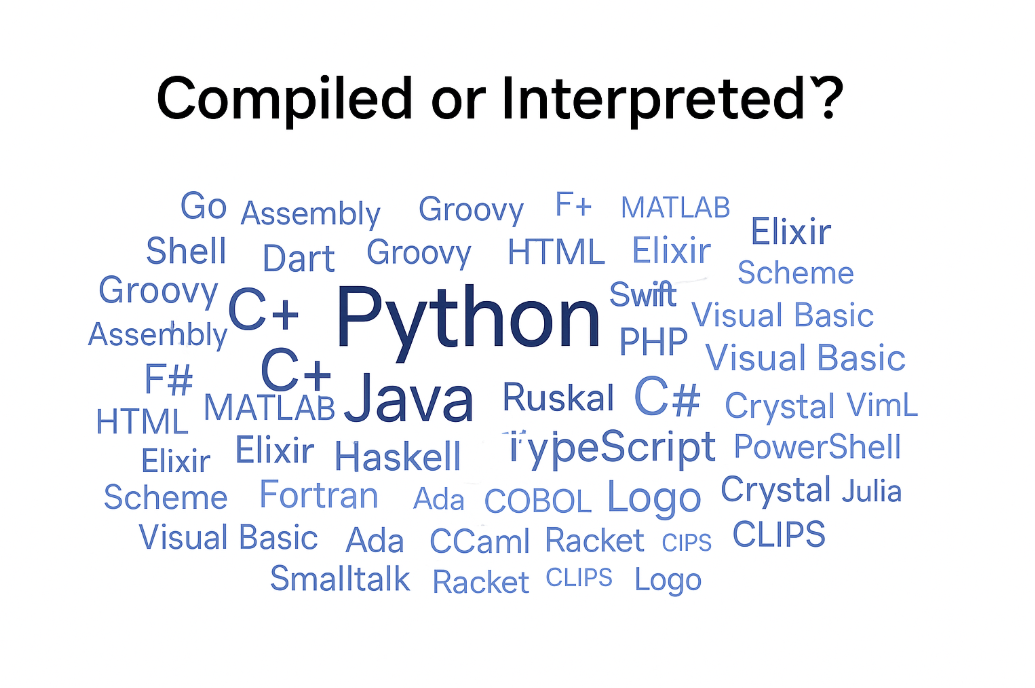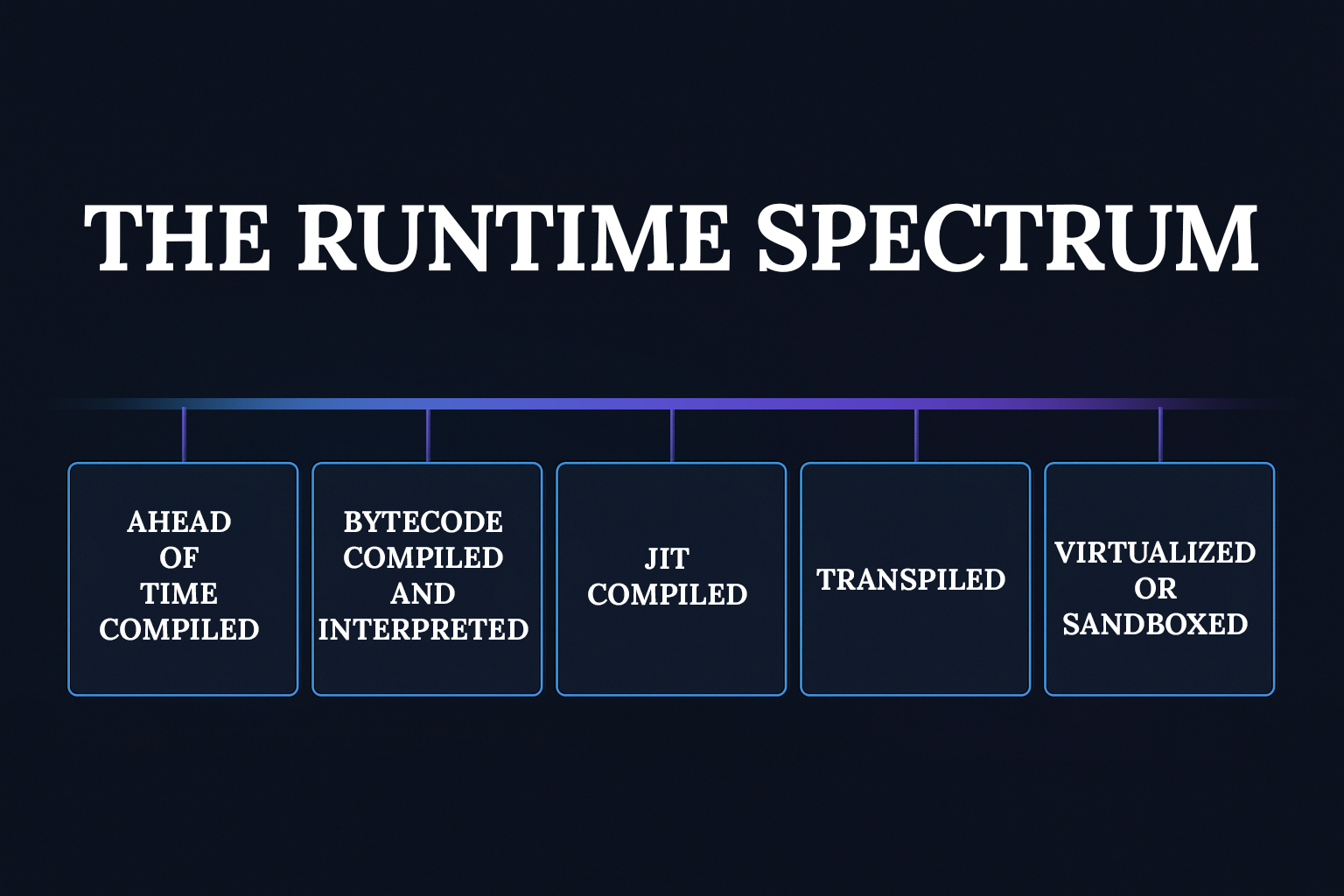For decades, computer science students have learned that programming languages fall neatly into two groups: compiled or interpreted.
If you studied programming around the late 1990s or early 2000s, you might recall this debate vividly:
“C is compiled, Python is interpreted. Java? Maybe both?”
Back then, this distinction was enough to explain why some programs ran faster than others. But the modern software landscape has outgrown that simplicity. Today, the boundary between compiled and interpreted languages is so blurred that most modern languages fall somewhere in between.
This article explores how that happened, from the early days of native machine code to today’s hybrid execution models that power the web, mobile, and AI.
1. The Classic View: Compiled vs Interpreted
In the early years of computing, system resources were scarce and software design was straightforward. Programming languages were classified based on how they execute code on a computer.
1.1. Compiled Languages
A compiled language uses a compiler to translate source code into machine code before execution. The resulting binary can then run directly on the hardware without needing the compiler or source files again.
Examples: C, C++, Pascal, Fortran, COBOL
Advantages:
- Fast runtime performance (machine-level execution)
- Efficient memory and CPU use
- Independent from interpreters or runtime environment
Disadvantages:
- Requires recompilation for each platform
- Longer development cycle (edit, compile, test)
1.2. Interpreted Languages
Interpreted languages execute code through an interpreter, a program that reads and executes the code line by line at runtime.
Examples: BASIC, Python, Perl, early JavaScript, MATLAB
Advantages:
- Easier debugging and experimentation
- Cross-platform execution
- Ideal for scripting and rapid prototyping
Disadvantages:
- Slower performance due to runtime translation
- Requires the interpreter to be present on every system
This two-category model worked perfectly for teaching the basics. But by the late 1990s, languages like Java began to change the rules.
2. The Hybrid Era: Bytecode and Virtual Machines
When Java arrived in 1995, it didn’t fit cleanly into either category. It wasn’t fully compiled, nor was it purely interpreted.
Java introduced the concept of bytecode, a platform-independent intermediate form of code that runs inside a virtual machine (the JVM).
How it works:
- Source code (.java) is compiled into bytecode (.class).
- The JVM interprets or JIT-compiles the bytecode at runtime.
This hybrid approach allowed developers to write code once and run it anywhere:
“Write once, run anywhere.”
Bytecode acts like a portable assembly language. It’s not tied to a specific CPU architecture, and the virtual machine ensures consistent behavior across platforms.
This design inspired other ecosystems such as Microsoft’s .NET framework, which uses an almost identical model (Intermediate Language plus Common Language Runtime).
3. The Rise of JIT Compilation
The next leap forward was the Just-In-Time compiler, or JIT. A JIT compiler analyzes bytecode at runtime and dynamically converts frequently executed parts, known as hot paths, into optimized machine code. This allows hybrid languages to approach, and sometimes match, the performance of fully compiled languages.
Common JIT-enabled platforms:
- Java HotSpot JVM
- .NET CLR
- JavaScript engines (V8, SpiderMonkey, Chakra)
- PyPy (JIT version of Python)
This evolution turned interpreted languages like JavaScript into engines capable of powering entire applications such as Google Chrome, VS Code, and Node.js.).
4. Transpilers, AOT Compilation, and Multi-Stage Execution
As programming evolved into the web era, new approaches emerged that combined compilation, transformation, and runtime optimization.
4.1. Transpiled Languages
A transpiler converts code from one high-level language into another. Unlike traditional compilers, transpilers preserve the human-readable structure of code.
Examples:
- TypeScript to JavaScript
- CoffeeScript to JavaScript
- SASS to CSS
This approach is now standard in web development: developers write modern syntax (like ES6+ or TypeScript), which is transpiled into browser-compatible JavaScript.
4.2. Ahead-of-Time (AOT) Compilation
Some modern languages compile everything before execution.
Examples:
- Go produces static binaries with no runtime dependencies.
- Rust offers near-C performance with full ahead-of-time compilation.
- Swift uses both AOT and JIT depending on platform.
- .NET Native and GraalVM provide AOT options for traditional JIT systems.
AOT compilation improves startup speed and security, which is especially useful for mobile and embedded devices.
4.3. Hybrid Runtime Pipelines
Modern execution environments combine multiple strategies:
| STAGE | COMPONENT | PURPOSE |
| Source | Developer writes high-level code | Human-readable input |
| Compiler | Converts to bytecode or IR | Platform-independent intermediate form |
| Runtime | Interprets or JIT-compiles | Executes efficiently on target CPU |
| Optimizer | Recompiles hot sections | Improves performance dynamically |
| Packager | Bundles everything | Produces portable binaries or apps |
Labeling a language as simply compiled or interpreted no longer captures the full picture.
5. How Major Languages Fit Today
| LANGUAGES | EXECUTION MODEL | COMPILATION TYPE | NOTES |
| C / C++ | Direct to machine code | Ahead-of-Time | Classic compiled model |
| Python (CPython) | Bytecode + Interpreter | Bytecode | Compiles to .pyc executed by VM |
| Java | Bytecode + JIT | Hybrid | JVM dynamically optimizes code |
| C# / .NET | Bytecode + JIT / AOT | Hybrid | CLR performs JIT or AOT |
| JavaScript | JIT | Hybrid | V8 compiles hot functions to native code |
| Go | Native Binary | Ahead-of-Time | Fully compiled static executable |
| Rust | Native Binary | Ahead-of-Time | Optimized performance and safety |
| TypeScript | Transpiled to JavaScript | Source-to-Source | Requires JavaScript runtime |
| PHP | Bytecode cache | Interpreted + Cached | Zend Engine compiles to opcodes |
Few languages today fit neatly into a single category. Each combines layers of compilation, optimization, and interpretation to achieve its goals.
6. The Spectrum of Execution
Instead of two boxes, think of language execution as a spectrum:

Where a language lands depends on:
- How its code is translated (bytecode, IR, or native)
- When compilation occurs (before or during execution)
- Whether runtime optimization is used
This explains why:
- Python can run faster with JIT (PyPy)
- JavaScript now compiles dynamically to native code
- Go and Rust, though compiled, support runtime-like features such as garbage collection
7. Why the Classic Debate Still Matters
Although outdated, the compiled versus interpreted distinction still helps teach foundational concepts like:
- Compilation versus execution time
- Machine code versus virtual machine code
- Performance trade-offs
- Platform independence
It also explains why certain languages behave differently, and why some need runtimes while others do not. However, clinging to the binary model can be misleading in evaluating modern technologies. Languages today are execution ecosystems rather than static definitions.
8. The Modern Understanding
Programming languages no longer fit into compiled or interpreted boxes. They operate across a multi-stage pipeline, compiling, interpreting, and optimizing code at various layers depending on the environment.
In practice:
- Compiled languages gained flexibility and runtime optimization.
- Interpreted languages gained performance through caching and native extensions.
The modern goal is no longer to choose between compiled and interpreted, but to combine the strengths of both for performance, portability, and productivity.
9. The Evolution at a Glance
| ERA | COMMON APPROACH | REPRESENTATIVE LANGUAGES |
| 1970s–1980s | Strict compiled or interpreted | C, BASIC, Fortran |
| 1990s | Hybrid bytecode and VM | Java, Python |
| 2000s | JIT compilation | JVM, .NET, JS engines |
| 2010s–2020s | Multi-stage, transpiled, AOT | Go, Rust, TypeScript, Swift |
Each era built on the previous one, merging ideas rather than replacing them.
10. The Bottom Line
In the early 2000s, calling a language compiled or interpreted was a useful shorthand. But in 2025, that distinction no longer defines how code truly runs.
Modern languages are:
- Compiled to optimize execution
- Interpreted to stay portable
- Transpiled to reach multiple platforms
- JIT-compiled to adapt dynamically
- AOT-compiled to ensure stability and speed
In short: Most languages today are both compiled and interpreted at different stages, by different layers.
They are no longer defined by translation method but by their execution ecosystem, a combination of compilers, virtual machines, and optimizers that make modern computing possible.
Final Thought
So the next time someone asks:
“Is this language compiled or interpreted?”
You can confidently say
“Neither and both. The real question is how it’s executed.”
Because the modern world of programming isn’t black and white. It’s a seamless blend of both, a continuous evolution toward faster, smarter, and more portable code.


